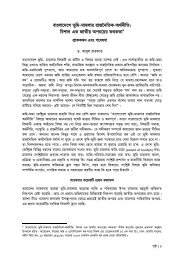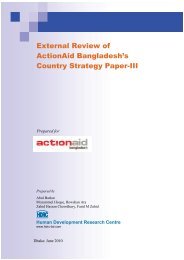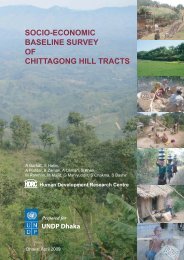08. Costing Essential Services Package An Issue Paper
08. Costing Essential Services Package An Issue Paper
08. Costing Essential Services Package An Issue Paper
Create successful ePaper yourself
Turn your PDF publications into a flip-book with our unique Google optimized e-Paper software.
<strong>Costing</strong> <strong>Essential</strong> <strong>Services</strong> <strong>Package</strong>: <strong>An</strong> <strong>Issue</strong> <strong>Paper</strong> 11<br />
Before entering into the review of ESP costing exercises it would be pertinent to point out the<br />
following two major issues which were confronted by all who were engaged in ESP costing:<br />
First: computation of capital costs is always difficult in a situation of regular foreign currency<br />
inflow and regular inflation with different rates. How should one tackle this situation in cost<br />
measurement? Once costs have been categorized as direct, indirect, or infrastructure, they can<br />
be classified as capital (or developmental) and recurrent (or operating). Those resources that<br />
have a life expectancy of 1 year or more usually are treated as capital costs (buildings, cars,<br />
trucks, beds, medical equipment, etc). The cost of a capital item is spread over its expected life,<br />
and the analyst must calculate what portion of total cost should be attributed to the time-bound<br />
program or program component. In doing so, the annualized cost of that item, using the<br />
remaining life expectancy of the used item (not the life expectancy at the time of original<br />
purchase) should suffice.<br />
Second, apportionment of joint costs is one of the most problematic areas of input valuation.<br />
In many instances one activity is combined with other activities. This is a situation of integrated<br />
inputs with multiple objectives and effects, or program activities are integrated with shared<br />
facilities. Thus, it is natural that when all such activities are simultaneously carried out by the<br />
same personnel, a situation of joint costs arises. It should be stressed that there is no single<br />
“correct” allocation methods for joint costs. In developing the best way out, distinctions are<br />
typically made between overhead and direct costs. Overhead cost is usually allotted among the<br />
various “departments” involved on some “reasonable” basis. Although there is a great variation<br />
in cost accounting systems, the final allocation of input costs is generally made, based on a<br />
“burden vehicle”, i.e., in direct proportion to that department’s product or output, e.g., direct cost<br />
of labour or labour hours utilized in the production of that output. These measures are usually<br />
predetermined. For example, if the overhead cost rate is given as equal to 75 percent for a<br />
family planning unit with a health operation, the direct labour cost is given as the “burden<br />
vehicle”; and each unit of clinic output is charged with Tk.0.75 for every taka of direct labour<br />
cost.<br />
Joint cost allocation, as would be evident in our subsequent discussion, poses a major problem<br />
while (ascertaining) estimating ESP part of the other than ESP components of HPSP. There<br />
are seven such components as shown in Figure 2.<br />
5. <strong>Costing</strong> <strong>Essential</strong> <strong>Services</strong> <strong>Package</strong> and Components thereof:<br />
Review of Experiences<br />
Comprehensive costing exercises for ESP introduced through the HPSP have been done by the<br />
Project Preparation Cell (PPC), and by the Health Economics Unit (HEU), both under the<br />
Ministry of Health and Family Welfare (MOHFW). <strong>Costing</strong> exercise for ESP components for<br />
thana level and below has been performed by Barkat et.al. (1999); some costing exercises for<br />
family planning and select MCH services has been conducted by Janowitz, et.al. and Rahman,<br />
et.al. (1996), costing projections for the national family planning program has been done in 1996<br />
(Barkat, et al. 1996), facility level costing study has been conducted by Rannan – Eliya and<br />
Somanathan (1999), and studies on costing of various service components have also been<br />
undertaken in the past. Because of differences in purpose and methodological frameworks<br />
applied, the outcomes of experiences are not comparable. However, all of the above exercises<br />
provide useful information which could be gainfully utilized in developing and designing an<br />
appropriate methodology for future costing of ESP. The review of such exercise will also give<br />
ample scope to identify our knowledge-gaps on the subject.






